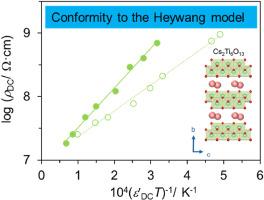Heywang模型在层状吸水性材料中PTCR效应研究中的应用
IF 3.5
3区 化学
Q2 CHEMISTRY, INORGANIC & NUCLEAR
引用次数: 0
摘要
表面质子/氢氧化物传导在环境条件下占主导地位,在高温下由于水蒸发和随后的电荷载流子损失而趋于稳定。这种水诱导的电荷输运导致“表观”正电阻率温度系数(PTCR)效应。本文表明,典型的经典铁电PTCR陶瓷Heywang模型适用于广泛的吸水性层状材料(0.17-4.76 wt% H2O)。几个例子包括带负电荷片的层状碱钛酸盐;一种具有中性薄片的范德瓦尔斯材料(g-C3N4);以及带正电荷片的NiFe层状双氢氧化物。在25 ~ 250℃范围内,观察到线性对数ρDC vs (ε’DCT)-1曲线(ρDC =静态电阻率,ε’DC =静态介电常数,T温度),其中电阻率和介电常数变化可达5个数量级。以Cs2Ti6O13为代表样品,在晶界处的受体态密度(确切性质有待阐明)为~ 1010-1011 cm-2,与加热/冷却速率(0.5、2和5°C·min-1)有轻微的关系。复平面分析表明,无论温度如何,晶粒/晶界处的电容都是恒定的,但两种情况下的电阻在150-200℃时达到峰值。虽然严格的理论基础尚未建立,但观察到的线性表明,到目前为止,这两类PTCR材料之间可能存在共同的基础。本文章由计算机程序翻译,如有差异,请以英文原文为准。

Application of Heywang model to the apparent PTCR effect in water-adsorbing layered materials
Surface proton/hydroxide conduction predominates at ambient conditions prior to levelling off at elevated temperatures due to water evaporation and subsequent loss of charge carriers. This water-induced charge transport results in the “apparent” positive temperature coefficient of resistivity (PTCR) effect. Herein, we show that Heywang model typical of classical ferroelectric PTCR ceramics is applicable to a wide range of water-adsorbing layered materials (0.17–4.76 wt% H2O). Several examples include layered alkali titanates with negatively-charge sheets; one van der Waals material (g‒C3N4) with neutral sheets; and a NiFe layered double hydroxide with positively-charge sheets. The linear log ρDC vs (ε′DCT)-1 plots (ρDC = static resistivity, ε′DC = static dielectric permittivity, and T temperature) are observed from 25 to 250 °C where resistivity and dielectric permittivity varied up to five orders of magnitude. Using Cs2Ti6O13 as a representative sample, the density of acceptor states at the grain boundary Ns (the exact nature to be elucidated) is ∼1010-1011 cm-2, slightly dependent on the heating/cooling rates (0.5, 2 and 5 °C·min-1). Complex plane analyses show that capacitances at grain/grain boundaries alike are constant regardless of temperatures, but resistances in both cases peak at 150–200 °C. While rigorous theoretical basis is yet to be constructed, the observed linearity suggests that there could be a common foundation between these two classes of PTCR materials which have been treated separately so far.
求助全文
通过发布文献求助,成功后即可免费获取论文全文。
去求助
来源期刊

Journal of Solid State Chemistry
化学-无机化学与核化学
CiteScore
6.00
自引率
9.10%
发文量
848
审稿时长
25 days
期刊介绍:
Covering major developments in the field of solid state chemistry and related areas such as ceramics and amorphous materials, the Journal of Solid State Chemistry features studies of chemical, structural, thermodynamic, electronic, magnetic, and optical properties and processes in solids.
 求助内容:
求助内容: 应助结果提醒方式:
应助结果提醒方式:


